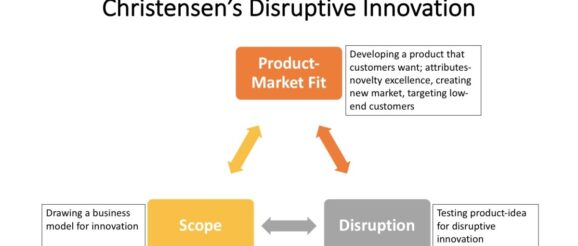What is disruptive innovation, and how does it work?

Concept
Disruptive innovation is a term coined by Clayton Christensen and means making a new product/service, inventing value propositions, creating a new market and customers, targeting low-end customers, and is best conducted by start-ups. On the other hand, incremental innovation differs slightly from disruptive one as it is often created by existing companies about existing products to secure a market share. Incremental innovation can improve features of demandable products, extend and enhance an existing line of production, or improve a business model. According to Moore’s book ‘ Dealing with Darwin’ 2005, disruptive innovations evolve in the market during the introduction and growth phases of the technology lifecycle and represent the product leadership zone. This product zone comprises disruptive innovations like breakthrough technology, technology product, applications, or platforms. The product leadership zone is evolved to the market by university labs, technology start-ups, early adopters (or entrepreneurs), and the early majority.

Background
Disruptive innovation is a business term coined by many innovation authors like Clayton Christensen (e.g., in the books- Innovator’s dilemma, 1997 and The innovator’s solution, 2003), Geoffrey Moore (e.g., in books- Crossing the chasm, 1991 and Dealing with Darwin, 2005), and Everett Rogers (e.g., book- Diffusion of innovations, 1962).
How does it work?
In Christensen’s book ‘Innovator’s solution’ 2003, the author described disruptive innovation as a collection of factors, including targeting a new demand of low-end customers with better offerings and lower prices. Thus, disruptive innovations often disrupt the market by offering more convenient products or products with upgraded features and lower prices than competitors. Here are some steps to create disruptive innovations (Christensen, 2003)1:
Develop a product that customers want
- Segment the market: identify a group of customers that are similar enough demographically and psycho-graphically, and the product idea will appeal to them all. Market segmentation can be done through researching, observing, interviewing and narrowing options with the right potential customers.
- Customer analysis: includes evaluating the customer segment target and identifying their jobs-to-be-done (professional, emotional and social), pains and desired gains. As we metaphor, any product, when purchased, is eventually hired, like a staff, to do a job for the specific customer segment; thus, the product should fit the needs of this segment.
- Understand target customers: after jobs, pains and desired gains are identified and prioritised, it is then time to conduct a deep understanding and validate collected data and conclusions. This process can be done through various tools, like observing, interviewing and, if possible, living with target customers to understand their jobs, pains, and gains.
- Understand competition: here, you need to understand the competition and how the market works. To do so, you need to collect and study information about the competition, including marketing strategy, positioning, market mix and conclusion opportunities.
- Choosing customer segment: criteria for selecting target customer segments may include customers having a compelling reason to buy the product, being well-funded to buy, easy to access, has significant potential to grow, and the size of the beachhead market viable.
- Aim at focusing: Disruptiveness requires a deep focus on designing and testing a business model, including identifying the customer segment target and value propositions.
- Value-customer fit: think about how to improve or create a product with unique value propositions that better fit customers’ needs.
- Non-existing market: go for the non-consumption product (untapped) to enjoy disruptive benefits (higher penetration rate of the market and growing revenues and profits).
- Solutions: last, you list recommended products (solutions) that best fit the jobs of target customers, as evidenced by sufficient data.
Test for disruptive innovation
- Creating a new demand: can your new product meet unmet needs? Is there a large population of people who can buy the referenced product? Can the business model be successful in selling and capturing the market segment?
- State your assumptions: they are four sets of assumptions: (1) customers accept your definition of the problem, (2) accept the solution, (3) will buy the product, and (4) will support growth.
- Testing: comprises three main tests: problem-solution, product-market, and scalability test. A test can be conducted through research, observation, and interviews with potential customers. A testing plan should be prepared before implementation and include a list of interviews, questions, criteria for acceptance or rejection, and an action plan. Final note, testing becomes successful if customers approve underlying assumptions.
Getting business scope right
- Draw a business model: develop and validate innovative business models to create, deliver, and capture values.
- Choose the scope of the model: decide on the input components of the product and whether to make or buy based on business competitive advantages factors. The best business model entails an integrated system in which some components are bought based on core differentiation bases. The business model based on making all product components (Modularisation) shall not support disruptive and sustainable requirements due to price competition and commoditization reasons. Developing a disruptive product should be based on an integrated production system with value supply chains.
- This post is sourced from my new book- Your Guide To Reach Innovation.
Final note: the book- Your Guide To Reach Innovation, is an actionable guide to innovation from beginning to end. Enjoy reading the book, and I look forward to your reviews.
Author: Munther Al Dawood
maldawood@growenterprise.co.uk
Reference:
- Christensen, C. 2003. The Innovator’s Solution, Harvard Business Review Press, Harvard.
